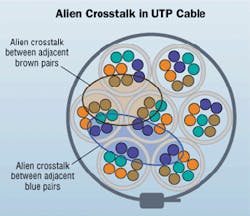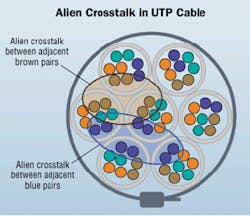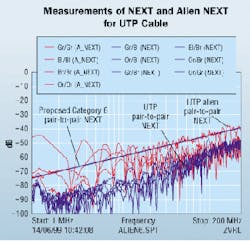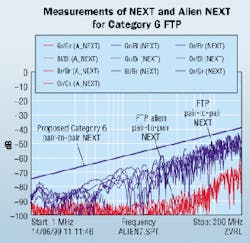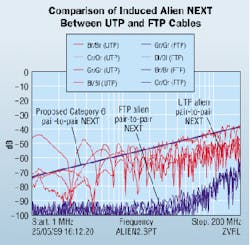Effects of alien crosstalk on the physical layer
How externally generated noise will affect Category 6 structured cabling systems.
Joel deNeuf / ITT Industries, Network Systems & Services
Alien crosstalk is the interference caused by a pair of wires in one cable inducing noise into other pairs of wires in adjacent cables. Alien crosstalk coupling is always worst between pairs of wires of the same color because the twist ratios of these pairs are virtually identical. In addition, power-sum coupling occurs among all pairs within adjacent cables (not just those of the same color), albeit at a lower measured level. That further adds to the total alien crosstalk noise coupled between cables.
Alien crosstalk noise interference is a combination of alien near-end crosstalk (NEXT) and alien far-end crosstalk (FEXT). Because it increases the noise level within the channel, thus decreasing the overall signal-to-noise ratio (SNR), alien crosstalk reduces the operational bandwidth of a cabling channel. It is due to this additional reduction in operational bandwidth that the ANSI/TIA/EIA standards committees are proposing that new NEXT and attenuation limits be considered for Category 6 structured cabling systems.
Alien crosstalk affects neighboring wire pairs and, more so, pairs of the same color.
This proposal is to ensure Category 6 can deliver its promise of 200 MHz of usable bandwidth consistently in an installed environment, where alien crosstalk will inevitably be present. These proposed changes are an attempt to ensure sufficient signal power is retained within a Category 6 cable channel under all installation conditions and the total noise level budgets of future Class E applications will not be exceeded. The effects of alien crosstalk must be allowed for and controlled within the proposed Category 6 standards legislation because they cannot be tested for or identified during the installation process.
Before the development of Gigabit Ethernet (GbE), alien crosstalk had not been identified as a significant source of noise. Even the fastest high-speed applications such as Fast Ethernet 100Base-TX were relatively undemanding of Category 5 structured cabling systems. Fast Ethernet operates using just two cable pairs and usually in half-duplex mode (transmitting only on one cable pair in one direction at a time).
However, GbE uses an encoding method that transmits data on all four cable pairs simultaneously and in both directions (full-duplex mode). This method is far more demanding on the cabling infrastructure and can result in alien crosstalk and power-sum alien crosstalk being generated within adjacent, parallel, unshielded twisted-pair (UTP) cables.
In addition, Category 6 UTP cabling systems can be more susceptible to alien crosstalk than many Category 5 systems. Because Category 6 cables are manufactured to tighter tolerances, the twist ratios are much more consistent from cable to cable, causing increasing levels of induced noise between almost identical cable-pair twist ratios in adjacent cables.
Scope of the problem
To date, the alien crosstalk testing completed by ITT Industries, NS&S, has concentrated on the effects of one "disturbing" cable on an adjacent "victim" cable. However, that is by no means the worst-case installation scenario. If cables are bundled together, the worst-case configuration could be seven cables assembled as shown in the figure below. In reality of course, measured levels of alien crosstalk are likely to fall somewhere between these two extremes, depending on the type of cable specified and whether the cables are bundled or loosely laid.
The level of alien crosstalk will also depend on whether the applications deployed are unidirectional or bidirectional and whether they use single-pair or multipair transmission methods. Bidirectional, multipair applications such as GbE produce higher levels of alien crosstalk because multiple active pairs send signals in both directions at once.
The test configuration simulated real-life installation procedures.
The effects of supporting multiple applications using the same operating bandwidth within a cable bundle may introduce even more intercable interference than transmitting multiple sessions of a single application, further exacerbating the alien crosstalk problem; however, that subject is outside of the scope of this article.
Alien crosstalk can be controlled in three ways:
- Through cable design by decreasing the combined sources of noise (NEXT, FEXT, and return loss) within the system, effectively increasing the overall SNR. This practice would involve changing the Category 6 draft specification limits.
- Through installation control by ensuring cables are not installed in such a way as to exacerbate the problem. This approach would preclude the use of bundled UTP cables, overfilling of conduits and trunking, or close-proximity parallel cable runs.
- Through the use of screened, balanced, twisted-pair cables.
Assuming a worst-case scenario as outlined above, attempting to control alien crosstalk through cable design alone may not provide the minimum necessary attenuation-to-crosstalk ratio (ACR) at 200 MHz required for Category 6 systems based on the currently proposed Category 6 specification.
Effective control of alien crosstalk during installation depends on so many variable factors that it is virtually impossible to implement. That, combined with the fact that alien crosstalk cannot be tested during or after installation, means that alien crosstalk installation recommendations, by themselves, are unlikely to be an effective, measurable method of control.
Since alien crosstalk is not internally generated by the victim cable, the active networking hardware cannot predict or "learn" the level of noise that may be present external to its own channel. This prediction and thus reduction of internally generated noise sources, such as NEXT and return loss, is used extensively within the GbE standard to increase the predicted SNR and, therefore, to reduce the bit-error-rate to an acceptable level. The unpredictable effects of alien crosstalk may seriously affect the minimum SNR requirement of GbE, even though it would appear that since GbE is a Class D application (designed to operate at frequencies up to 125 MHz), there should be no performance restrictions when it is implemented over a Category 6, Class E (200-MHz) channel.
Test configurations
We devised tests to compare the levels of alien crosstalk that are induced into Category 6 UTP and foiled twisted-pair (FTP) cables from adjacent parallel cables of the same construction type. We compared the measured levels of alien crosstalk to the internally generated NEXT noise within the cable.
We used the following equipment:
- Rohde & Schwarz ZVRL vector network analyzer.
- Minns impedance-matching baluns and 100-ohm balance resistors.
- Two 90-meter lengths of Category 6 UTP cable.
- Two 90-meter lengths of ITT Industries, NS&S, ISCS XE Category 6 FTP cable.
- Cable ties and tools.
The Category 6 UTP cables to be tested were cut to 250-ft lengths and laid out to simulate installed conditions. Then the cables were tied together at 1-ft intervals, ensuring the cable ties were not over-tightened. The Category 6 FTP cables were configured the same way.
In tests on unshielded twisted-pair cable, pair-to-pair alien NEXT exceeded the proposed Category 6 NEXT limit.
The testing apparatus was set up with the vector network analyzer set to sweep and measure results from 1 to 200 MHz. All cable pairs not being used during testing were terminated with 100-ohm resistors. The cables under test were connected to the network analyzer via the impedance-matching baluns, with an operating bandwidth of 1 to 250 MHz.
Test 1 was carried out on Category 6 UTP cable using the network analyzer to directly compare the level of internally induced NEXT noise with externally induced alien crosstalk noise. The test was then repeated using the Category 6 FTP cables. The six measured NEXT results were combined with the alien NEXT results obtained during test 2. The results were recorded and plotted.
Tests showed that in foiled twisted-pair cable, pair-to-pair alien NEXT was much lower than internally generated NEXT.
Test 2 measured alien NEXT by generating a signal from the network analyzer on the blue pair of a Category 6 UTP cable and measuring the noise induced into the blue pair within the adjacent Category 6 UTP cable at the same end that the signal was generated. Testing was then repeated for the other three cable-pair colors. All four tests were then repeated using the Category 6 FTP cables. The results were recorded and plotted.
Detailed test results
Test 1-UTP cables. The figure below compares the level of internally generated NEXT with externally induced alien NEXT from the adjacent Category 6 UTP cable. Alien NEXT is a significantly larger contributor to the overall noise within the system when compared to the highly controlled internally generated NEXT noise. It actually exceeds the NEXT values contained within the draft Category 6 specification document because the twist ratios of the worst-case, same-pair-color disturbers are the same in both cables, leading to very poor intercable noise rejection. Alien NEXT is a larger system noise contributor at lower frequencies than at higher frequencies.
Test 1-Category 6 FTP cables. The figure below compares the level of internally generated NEXT with externally generated alien NEXT from the adjacent FTP cable. It can be clearly seen that alien NEXT is an insignificant contributor to the overall noise within the system when compared to both the NEXT noise generated within the cable and the proposed Category 6 NEXT limit.
Test 2. The figure on page 60 shows alien crosstalk comparison test results from both UTP and FTP cables. All tests were repeated a total of five times and worst-case results recorded to ensure repeatability. The level of alien NEXT measured between the Category 6 UTP disturbing and victim cables actually exceeds the maximum allowable power-sum NEXT values (the dark blue limit line) contained within the draft Category 6 standard.
Foiled twisted-pair cables showed much less alien NEXT than did unshielded twisted-pair cables.
Measurements were carried out only between two adjacent cables and not with the theoretical worst-case configuration of six disturbers and one victim, the results of which would have been considerably worse. That is the case only when measuring Category 6 UTP cables. FTP cables of all types demonstrated excellent immunity to alien crosstalk. The overall system SNR is, therefore, preserved from alien crosstalk degradation by the use of an FTP cable.
Implications for Category 6 systems
The International Organization for Standardization (ISO-Geneva) is reviewing the bandwidth-reduction effect that alien crosstalk will have upon the emerging Category 6/Class E channel to ensure the original 200-MHz positive power-sum ACR design goals are consistently achieved when systems are installed. The option being considered at this time is to design a test method to measure the alien crosstalk from adjacent cables against a maximum specified limit.
If the coupled alien crosstalk exceeds this value, then steps will need to be taken to minimize the effects this source of noise will have on adjacent parallel cables. This solution could be through internal cable design changes or through controlled installation practices. The implications for currently installed Category 6 systems and cabling are enormous and may result in a failure to meet the Category 6 standard when it is published and an inability to support future high-speed Class E applications or even GbE.
Future Class E applications that will be designed to operate over the emerging Category 6/Class E cabling infrastructures will need to allow for the effects of alien crosstalk within their electrical design requirements if UTP cables are going to be considered for physical-layer connectivity. Alien crosstalk can be a significant source of external noise interference that cannot be controlled within UTP cables through the use of highly balanced twisted-pairs alone. In theory, balanced cables are just that-perfectly balanced-with no emissions possible between cable pairs. In reality, however, a perfectly balanced cable is impossible to manufacture, terminate, and install; therefore, emissions from cable pairs do occur, causing alien crosstalk interference into adjacent cable pairs. Screened cables overcome the problem of alien crosstalk by screening adjacent cables from each other, thereby preserving the Category 6 (200-MHz) available bandwidth and ensuring the error-free operation of future high-speed applications.
Installation issues
In fully loaded conduit and trunking systems, bundled or close-proximity parallel runs of Category 6 UTP cabling are undesirable because of the erosion of system bandwidth by alien crosstalk, whereas Category 6 high-performance FTP cables installed the same way remain immune to alien crosstalk interference.
If alien crosstalk between adjacent UTP cables has to be minimized through the use of controlled installation practices, the implications are that cables will have to be deliberately installed in a nonparallel, loosely laid fashion over their entire length. For most installations, that is impractical. Indeed, at least one manufacturer has recommended that trunking and conduits should not be filled to more than 40% capacity to limit the effects of this problem.
Current accepted good installation practices, which bundle cables using cable ties at regular intervals, may therefore be precluded because of the potential effect of alien crosstalk intercable interference. There will be a particular issue with vertical UTP cables that need to be regularly cable-tied to supporting metalwork to provide adequate cable support.
If alien crosstalk cannot be controlled by a combination of cable design, installation control, or screening, then the only way that Category 6 positive power-sum ACR can be secured is by reducing the length of the installed channel, thus reducing the channel attenuation. Current draft performance standards and accepted installation methodologies and practices will have to change to guarantee the installed ACR performance of Category 6 UTP systems. Category 6 cables that do not comply with the minimum alien crosstalk requirements being discussed within the ANSI/TIA/EIA and ISO will need to find some other method to reduce intercable interference to a level where it does not affect performance.
It can no longer be assumed that UTP cables will provide a suitable stable platform for high-bandwidth, high-speed applications because alien crosstalk can erode the channel bandwidth to an unacceptable level simply through the act of installing the cabling system. Taking into account the issues raised by our tests, it warrants raising the question: Have we finally reached the useful bandwidth limitation of UTP cabling systems?
Joel deNeuf is product manager North America at ITT Industries, Network Systems & Services, in New York City.
Second Annual Salary Survey
Cabling Installation & Maintenance is conducting its second annual salary survey of the telecommunications industry. To participate, fill out the form on our Website (www.cable-install.com)-and pass the word. The more people who participate, the better information we can provide you. We will publish the survey results in Cabling Installation & Maintenance later this year.
